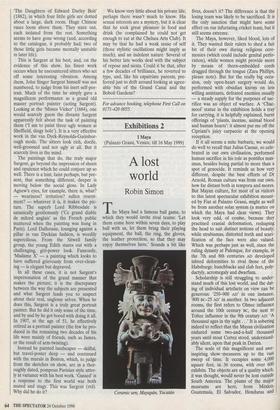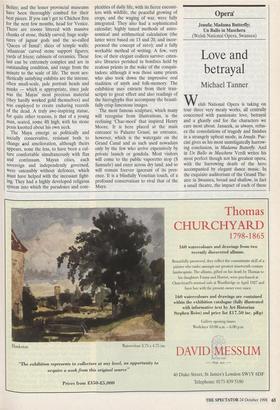Exhibitions 2
I Maya (Palazzo Grassi, Venice, till 16 May 1999)
A lost world
Robin Simon
The Maya had a famous ball game, to which they would invite rival teams: 'Let them come here within seven days, to play ball with us, let them bring their playing equipment, the ball, the ring, the gloves, the leather protection, so that they may enjoy themselves here.' Sounds a bit like Ceramic urn, Mayapdn, Yucatan fives, doesn't it? The difference is that the losing team was likely to be sacrificed. It is the only sanction that might have some effect on our infuriating cricket team, but it still seems extreme.
The Maya, however, liked blood, lots of it. They wanted their rulers to shed a fair bit of their own during religious cere- monies (which could include genital perfo- ration), while women might provide more by means of thorn-embedded cords dragged through the tongue (Zara Phillips, please note). But for the really big occa- sion, only open-heart surgery would do, performed with obsidian knives on less willing assistants, defeated enemies usually a steady supply for the purposes of sac- rifice was an object of warfare. A `Chac- mool' statue in the exhibition holds a tray for carrying, it is helpfully explained, burnt offerings of 'plants, incense, animal blood and human hearts': it almost put me off the Cipriani's juicy carpaccio at the opening reception.
If it all seems a mite barbaric, we would do well to recall that Julius Caesar, so cele- brated in our own civilisation, performed human sacrifice in his role as pontifex max- imus, besides being partial to more than a spot of genocide. It reminds us how very different, despite the best efforts of Dr Arnold, Roman culture was from our own, how far distant both in tempora and mores. But Mayan culture, for most of us visitors to this latest spectacular exhibition mount- ed by Fiat at Palazzo Grassi, might as well be from another solar system (a matter on which the Maya had clear views). They look very odd, of course, because they practised cranial deformation, reshaping the head to suit distinct notions of beauty; while strabismus, distorted teeth and scari- fication of the face were also valued. Which was perhaps just as well, since the ruling dynasty at Palenque, for example, in the 7th and 8th centuries AD developed inbred deformities to rival those of the Habsburgs: hunchbacks and club feet, poly- dactyly, acromegaly and dwarfism.
Scholarship is still struggling to under- stand much of this lost world, and the dat- ing of individual artefacts on view can be generous: '250-900 AD' in one instance, '800 Bc-25 AD' in another. In two adjacent rooms, the first refers to Olmec influence around the 10th century BC, the next to Toltec influence in the 9th century AD: 'A thousand ages in thy sight .. .' It is sobering indeed to reflect that the Mayan civilisation endured some two-and-a-half thousand years until stout Cortez stood, understand- ably silent, upon that peak in Darien.
The scale of this magnificent and awe- inspiring show -measures up to the vast sweep of time. It occupies some 4,000 square feet, in 36 rooms, with over 600 exhibits. The objects are of a quality which, it was thought, would never be lent outside South America. The plums of the major museums are here, from Mexico, Guatemala, El Salvador, Honduras and Belize; and the lesser provincial museums have been thoroughly combed for their best pieces. If you can't get to Chichen Itza for the next few months, head for Venice. There are rooms littered with massive chunks of stone, thickly carved; huge sculp- tures of jaguar gods and the so-called 'Queen of Ixmar; slices of temple walls; `atlantean' carved stone support figures; yards of frieze; cabinets of ceramics. These last can be extremely complex and are in outstanding condition, and range from the minute to the scale of life. The most aes- thetically satisfying exhibits are the intense, often small-scale, jade portrait heads and masks — which is appropriate, since jade was the Mayas' most precious material (they hardly worked gold themselves) and was employed to create enduring records of the dead. A truly awe-inspiring statue, for quite other reasons, is that of a young man, seated, some 4ft high, with his stone penis knotted about his own neck.
The Maya emerge as politically and socially conservative, resistant both to change and amelioration, although theirs appears, none the less, to have been a cul- ture comfortable simultaneously with flux and continuum. Mayan cities, each sovereign and independently governed, were ostensibly without defences, which must have helped with the incessant fight- ing. They had a highly developed religious System into which the paradoxes and com- plexities of daily life, with its fierce encoun- ters with wildlife, the peaceful growing of crops, and the waging of war, were fully integrated. They also had a sophisticated calendar; highly tuned methods of astro- nomical and arithmetical calculation (the latter were based on 13 and 20, and incor- porated the concept of zero); and a fully workable method of writing. A few, very few, of their elegant codices survive: exten- sive libraries perished in bonfires held by zealous priests in the wake of the conquis- tadors; although it was those same priests who also took down the impressive oral tradition of myth and folk-memory. The exhibition uses extracts from their tran- scripts to great effect and also readings of the hieroglyphs that accompany the beauti- fully crisp limestone images.
The most famous sculpture, which many will recognise from illustrations, is the reclining `Chac-mool' that inspired Henry Moore. It is here placed at the main entrance to Palazzo Grassi, an entrance, however, which is the watergate on the Grand Canal and as such used nowadays only by the few who arrive expensively by private launch or gondola. Most visitors will come to the public vaporetto stop (S Samuele) and enter across dry land, and so will remain forever ignorant of its pres- ence. It is a blissfully Venetian touch, of a profound conservatism to rival that of the Maya.



















































































 Previous page
Previous page